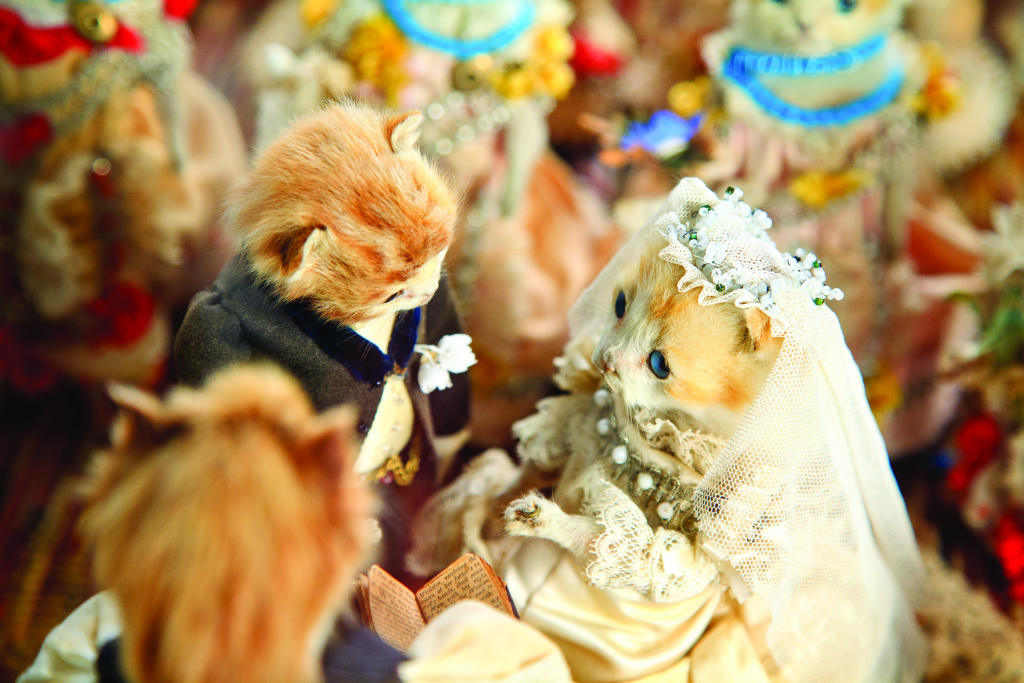Taxidermy: Art, Science & Immortality Featuring Walter Potter’s Kittens’ Wedding
 September 1 - December 6, 2016 (Extended due to popular demand)
September 1 - December 6, 2016 (Extended due to popular demand)
Curated by J. D. Powe
Text by J. D. Powe and Evan Michelson
This exhibition seeks to illuminate the strange and profound human connection to preserved animals through the exhibition of seldom-seen taxidermied treasures from private collections. The centerpiece of the exhibition will be The Kittens’ Wedding, the final and perhaps most unforgettable of all of the works of Walter Potter, completed in the 1890s. Equal parts perverse and adorable, and utterly spellbinding, The Kittens’ Wedding transcends kitsch through its tenderness and sensitive attention to detail.
The Kittens’ Wedding was created by Walter Potter, a self-trained British Victorian country taxidermist best remembered for a series of anthropomorphic tableaux in which he posed stuffed animals such as kittens, rabbits and squirrels as if engaging in human activities. These works were exhibited for nearly 150 years until the museum he founded was divided at auction in 2003. The pieces then moved the homes of private collectors around the world, most of them never shown since.
The practice of preserving dead animals extends back to Ancient Egypt, where cats, crocodiles and other creatures were mummified as part of elaborate funerary rituals. Preservation through taxidermy (from the Greek for “arrangement of the skin”) is a much more recent phenomenon that reached a zenith of popularity in England during the late 19th century. The Victorian era saw a keen interest in the study of natural history, appropriate for a time of ever-increasing global exploration and an ever-greater understanding of the mechanisms of the natural world. Taxidermy (once the provenance of curiosity cabinets) became prevalent in the Victorian home; even modest parlors displayed birds under glass, and no gentleman’s library was complete without a taxidermy diorama or two in a glazed case. At the height of this mania, taxidermy displays became ubiquitous, eventually blurring the lines between scientific specimen and decorative art. Many small towns had their own resident taxidermist, and guides for home crafts contained instructions for how to gut, stuff and arrange songbirds for a pleasing domestic display.
Humans have a long and curious history with our fellow animals. We love them, eat them, wear them, revere them, breed them, hunt them, fear them, rescue them and destroy them. In a time of greatly decreasing biodiversity there’s a greater respect the ever-dwindling population of our fellow beasts, but this wasn’t always the case. For centuries, nature was widely seen as vast and inexhaustible, filled with wonders, terrors and curiosities. Before the modern conservation movement, wild animals were commonly treated as natural resources to be exploited for their hides, feathers, teeth, bones and fur. Until just a few decades ago there were few protections for either wild or domestic animals. Most of the displays in this exhibition reflect that reality.
We are still familiar with hunting trophies and scientific specimens, but the sight of taxidermied domestic animals can cause unease in contemporary viewers. Cats especially have a strange history with humans; alternately worshipped and cursed throughout history, they were widely (and conflictingly) seen as beloved pets, working animals and expendable, overpopulating pests by the 19th century. The objects on display here are witness to the fact that one era’s cultural norm often becomes incomprehensible over time. What never changes is the strange, persistent, uniquely human desire to simultaneously destroy and immortalize those things we seek to understand, and those things we love.